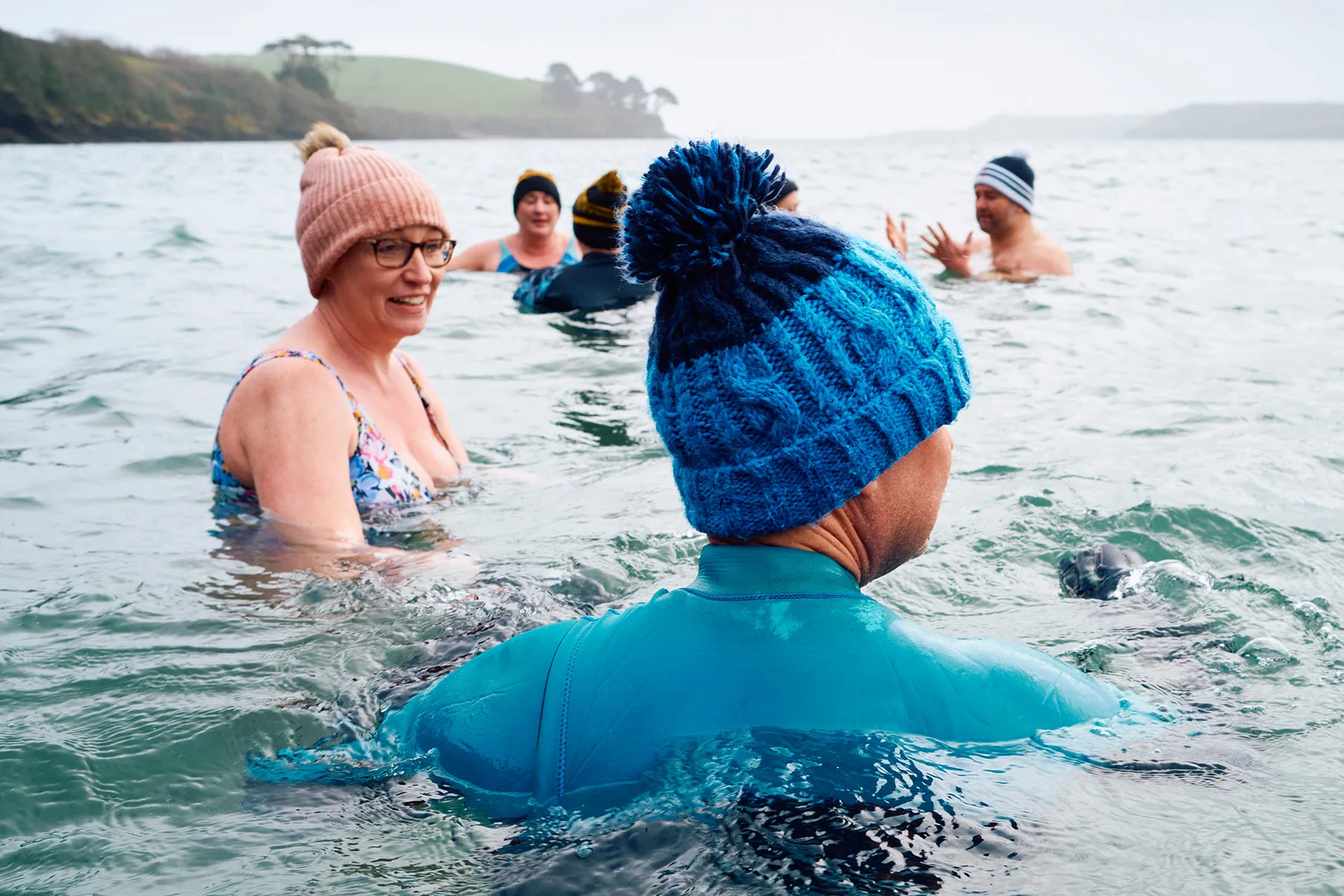
[ad_1]
March 13, 2024 – There’s a good chance you’ve come across this popular 10-second social media narrative:
Hard-bodied individual looks into the camera. Zooms out to show they’re wearing only a beanie and a bathing suit. Hey, I’m about to dunk myself in freezing water. Voluntarily! Because I love-hate-love-hate it! Really! You should too.
Should you?
Everywhere we look, someone is dunking something somewhere. Hot water. Ice water. Faces. Feet. Full bodies.
And for good reason: Water – in many forms and in many ways – heals.
More and more research is finding that water immersion can help ease muscle pain, boost relaxation, and improve circulation, among other benefits, said Judy Ho, PhD, a clinical neuropsychologist and associate professor at Pepperdine University in Los Angeles.
“It makes sense in so many ways because water is an easy way for people to have a sensory experience to tap into mindfulness,” she said.
Plus, there are biological underpinnings. Submersing yourself in water influences many body systems – cardiovascular (your heart and blood vessels), respiratory, endocrine (glands that make hormones), and more. “It’s probably the gestalt of all of them that makes [water immersion] helpful, beneficial, and useful,” said Bruce Becker, MD, a clinical professor at the University of Washington School of Medicine in Seattle who has researched and lectured on aquatic therapy.
We asked Becker, Ho, and others to explain the science behind five popular methods. Ready? Let’s dive in.
Cold Plunge
Though research is in its early stages, pilot studies have linked cold-water immersion to improvements in blood pressure, mood, and depression, said Heather Massey, PhD, a senior lecturer at the University of Portsmouth in the U.K. who studies cold-water immersion. A variety of reasons could be involved, including reduction of inflammation and stimulation of the vagus nerve, “which can make the heart rate and body calm down – and provide the spaces to be in the moment as opposed to being a thousand miles an hour,” Massey said.
Other research has linked cold-water immersion with reduced body fat and improved insulin sensitivity, though most of these studies are small and inconclusive.
Keep in mind an icy plunge is not without risks. The cold can trigger a shock response, increasing blood pressure, breathing rate, and heart rate in the first 30 seconds before the effect subsides. That can raise the risk of problems with your heart and blood vessels, such as arrhythmias, and the risk of drowning.
If you have such risks, talk to your doctor before trying a cold plunge. Get in gradually (don’t jump in to get it over with) to reduce the effects of cold shock and so you don’t block an airway underwater if you reflexively gasp, Massey said.
While there’s no ideal “dose” of cold immersion, “we know that colder and longer are not better; in fact, the shorter immersions may be responsible for lifting mood,” Massey said, adding that lower temps, even if not freezing, can lead to vascular and nerve injuries, especially in the extremities. One good starting point if you’re new to it: About 5 minutes at temps between 50 and 59 F.
If you do not have access to cold-plunge pools, do-it-yourself models can include soaking in a cool or cold bath (add ice if you can tolerate it) or taking cooler showers.
Hot Tub
Besides being, well, a lot more comfortable than cold plunges, heat therapy is also linked to cardiovascular health, said Tom Cullen, PhD, an assistant professor at Coventry University in the U.K. who has studied heat therapy.
“Passive heating” may mimic some effects of exercise on the body, according to Cullen’s review of studies in the Journal of Applied Physiology. “We think a lot of it is due to the increase in blood flow to the skin, which is forcing a large volume of blood through to our arms and legs,” Cullen said. This stresses the heart and blood vessels, strengthening the cardiovascular system in a way similar to exercise. It may also reduce anxiety and lower stress hormones, he said.
To see the cardiovascular effects, you need about 30 minutes in water heated to 102 F, Cullen said. “You can probably go shorter – 15 minutes – and slightly cooler if you just wanted the improvements in mood, relaxation, and a slight drop in blood pressure.”
Face Dunking in Ice Water
Touted as a quick way to relieve anxiety, this TikTok hack does have some science behind it: When you’re in fight-or-flight mode, your body temperature, heart rate, and stress hormones increase to prepare your body for the literal or symbolic bear you’re facing. Cold water activates your parasympathetic nervous system – the one linked to rest and relaxation – to trigger a biological response that tells you to calm down, Ho said.
Why dunk the face? “There are so many nerves in the face, so it’s the quickest way to activate the response,” she said. “And just the proximity to the brain. It’s the idea that we’re just trying to get that message to the brain as quickly as possible.”
Caveat: You shouldn’t ever feel overly uncomfortable or be gasping for breath. Splashing cold water on your face, putting a cold pack on your neck, or just holding an ice cube somewhere on your face can have similar effects, Ho said.
Foot Bath
A foot soak in warm water doesn’t just feel good but may also help you sleep and manage pain. One possible reason: It affects the thermoregulation systems of the body, which can influence core body temperature. After a warm foot bath, body temp goes down, which can promote quality sleep.
A 2023 study found a warm footbath improved sleep quality in patients who’d just had back surgery. Another study in the Journal of Caring Sciences found that sleep quality in older men improved with nightly 20-minute footbaths (the study lasted 6 weeks). Other research shows similar results in menopausal women and has found that footbaths can ease pain that comes with menstruation.
Swimming
This may be the most obvious one, but there’s a specific reason swimming is an ideal exercise beyond just cardiovascular benefits and low impact on joints.
Swimming can increase both heart rate and the volume of blood being pumped by the heart (both good things during exercise) better than other forms of activity because of the hydrostatic pressure, Becker said. That’s the force of the water pressing against you, and it helps drive fluid through the body. (One interesting area of emerging research, he said, is the effect on the brain of swimming and vertical-water exercises like underwater running, as increased blood flow may help improve thinking skills as we age.)
As with cold plunging, more people are taking to cold, open-water swimming. Though people swam in cold water before the pandemic, the practice got more popular when people were forced away from doing their normal activities, said Massey, a lifelong cold-water swimmer. “Many have remained a cold-water swimmer or dipper ever since,” she said.
Again, following precautions is important because it does come with risks, especially for those new to the experience. An article in the British Medical Journal reported a significant increase in lifeguard calls and deaths related to an increase in cold-water swimming.
But when done safely, the activity may have similar health benefits as cold plunging. In addition, a recent study in Post Reproductive Health showed that menopausal women had symptom relief with cold-water swimming.
Another benefit: It forces us into a state of being uncomfortable. “When we do experience discomfort, that’s how we maintain our health and well-being,” said Massey, adding that exercise (cold-water or not) is a form of discomfort. “Putting ourselves in a position of discomfort helps us adapt and maintain some elements of health.”
[ad_2]
Source link






